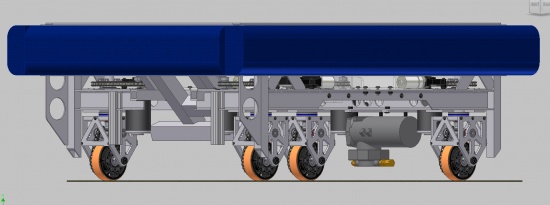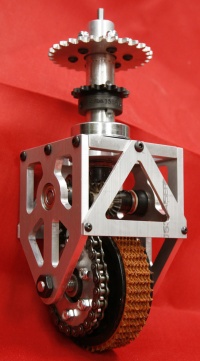DEWBOT VI
Contents
Documentation
Breakaway documentation page - you can get individual sections here
DEWBOT VI Build
The build season lasts 45 days, starting with a cold January morning and ending up in the middle of an even colder February night. The chronicles of the DEWBOT VI Build season make interesting reading of how we all band together to perform an almost impossible task of designing, building and testing a robot in such a short time frame. Associated with each weeks build are pictures showing happy (and towards the end, tired) roboteers and mentors hard at work.
Design Details
The links below will take you to details about the robot components.Drive Train
- DEWBOT VI utilizes a multi-mode, 4-wheel pivot drive-train. Each wheel is independently driven and steered. If we do this well (from both a mechanical and programming perspective), we should have an extraordinarily maneuverable robot and one well-suited to 2010's BREAKAWAY competition. Pivot Drive was selected for:
- Its superior maneuverability. This should be especially valuable in aligning with soccer balls and with the goal.
- Safety while crossing the bump. A 6wd robot would tilt over further during the climb and would also experience two tipping points. The second of these (coming off the flat top of the bump) will put the robot at a considerable tipping risk unless center of mass (CoM) is very low.
- DEWBOT VI is able to safely cross the bump and also drive through the tunnel. For both of these actions, the robot will need to drive in its long (x) axis direction. Chassis orientation is important for us in BREAKAWAY.
Mechanical / Scoring
- DEWBOT VI’s scoring strategy is focused on scoring soccer balls. Towards this, we should be able to:
- Herd up to 3 soccer balls and push these into the goal if playing in the alliance zone
- Herd balls with the robot side as well and also push into the goal using the side.
- Kick the ball towards the goal. We expect to be able to reliably score from Mid-field and to at least be able to reliably move balls from the opposing zone to the alliance zone with a single kick over both bumps. Bonus if we can reliably score from the opposing zone.
- Clear soccer balls from the tunnels
- DEWBOT VI has no provisions to Elevate or Suspend.
Tactical
Electrical
This years wiring supports a number of different elements.
- Drive Train - as discussed above the drive train is driven by 8 motors. On each pivot is a drive motor and a steering motor. Magnetic sensors track the steering position of each pivot
- Gyrocompass - keeps track of the overall direction of the robot in relationship to the field. Even though the robot will twist and spin, it knows what direction the goal is in.
- Camera - we us a web camera to find and zero in on the goal. Above the goal is a black and white bulls eye target. The programming uses the input from the camera and gyrocompass to aim and fire at the target.
- IR Sensors - there are two IR sensors mounted at the front of the robot. These sensors can track the soccer ball from 5 feet away. This allows us to move up and "capture" the ball with our possessor.
- Possessor - is a sticky cylinder rotating at high speed. When it goes in one direction the ball is drawn to the robot (we are putting "back-spin on the ball". In the other direction it gives the ball a gentle kick towards the goal. The direction and speed of the possessor is controlled by the cRio control computer.
The electrical page has details of the build season. Read all about the activities and see the details of the wiring.
- Electrical Team Page is the discussion page on current activities and to do items (it may or may not be empty
Pneumatics
- DEWBOT VI uses pneumatics to cock the Kicker and to release (fire) it.
- The robot has an on-board compressor and (4) Clippard compressed air storage cylinders.
- There are (2) solenoids: one to cock the Kicker (pushing back the Kicker thereby tensioning the elastic "springs") and the second to latch the Kicker in or release the Kicker from this tensioned ("armed") state.
- The cocking cylinder is a 2" bore x 4" stroke Bimba cylinder. It also has a 1" bore "helper" on the same air circuit.
- The latching cylinders are 3/4" bore x 1/2" stroke.
Programming
- Programming for this years robot is more complex than any other year. While there are two modes, an autonomous mode where the robot drives itself and a teleop mode where roboteers drive the robot, there is a huge amount of shared programming.
- The largest amount of programming is used to manage the drive train. As chronicled above we have a pivot drive. Each pivot has it's own drive motor to move the robot. By varying the speed of each wheel the robot direction can be changed. If you make the right side drive motors go faster than the left the robot moves in a gentle arc to the left.
- The pivots also turn 360 degrees. Each pivot has it's own steering motor and a magnetic sensor. The sensor tells us what "direction" the pivot wheel is turning. So if we want to move to the left, we rotate the wheels 90 degrees to the left and apply power and the robot moves, looking like a crab. This is motion is call strafing, allowing us to quickly move side to side across the field.
- The wheels can turn at any angle, allowing the robot to go in any direction. This crab like motion allows us to get to the ball while keeping the front kicker towards the goal. We strafe or crab over, align and kick.
- On the fly we can change modes to "snake mode." This allows the robot to act like a snake going after prey. In our case the ball is the prey, snake mode keeps the ball in front of the robot (snake) while the back of the robot moves around. This allows us to herd balls into the goal.
- Since the wheels can turn 360 degrees the robot can spin around on it's axis allowing us to reorient directions quickly.
- Finally while there is a "front" on DEWBOT VI where the kicker is, as far as the drive system is concerned there is no front. If you rotate the robot 90 degrees to the right, what was the left side is now the front.
- So it's like rubbing your stomach while patting your head while chewing gum while running!
Autonomous Mode
- At the start of the match the robot has 20 seconds to try to score on it's own. The plan sounds simple: Roll forward, find a ball, align the robot, kick the ball and SCORE! In reality we need to move forward so far, use the IR sensors to find the ball, use the camera and the gyrocompass to find the target, use the drive system to line up the shot and fire the kicker. Easy Peasy!
Teleop Mode
- This is where the two person drive team gets to show their stuff. They move the robot around, find balls and shoot them into the goal. Wait, that sounds like the autonomous mode, just use that. Well we do, the targeting system shows us where the goal is and when we are aligned. The reason the roboteers are needed is that under autonomous the balls are sitting still, now they are moving. And there is not just one ball there could be 12 of them on the field. Oh did we mention the other 5 robots?
- So it gets a little wild and crazy and while our programmers are good, the roboteers drive the show. The robot is still doing a lot of work, it's doing the drive train, tracking the goal and automatically cycling the kicker. There is lots of teamwork going on!
Weight
- DEWBOT weighs in at 112.2 lbs. without the bumpers or the battery. The max weight is 120 lbs so we are comfortably under. Our only design change to mitigate weight was reducing the robot's polycarbonate cover thickness from 3/16" to 1/16", saving about 5.5 lb.
- The bumpers weigh 12.6 lb per set (there are two sets, red & blue), also well under the 20 lb maximum.
- Robot Center-of-Mass (with bumpers & battery installed) corresponds to the Center-of-Wheelbase (17.5" from rear edge of chassis frame) and 9.75" above the playing field.
Bumpers
- One of the key element in the robot construction is the bumpers. They are a key safey feature of the robot since there is a reasonable amount of inter-robot contact. (And they say the NFL is tough). The bumpers have stringent size requriements, but the most important feature is that they go on and off the robot quickly. Rizzo created and fabricated an elegant but simple system in 2009. He refined it in 2010 to the system that we are using.
- Detailed drawings can be found on the Bumpers Page.
Events
- Second Bay at DEC
- Downingtown Area Robotics expanded into a 2nd bay at DEC. The new bay will be used for FRC and VEX storage. The original (larger) bay will house our power tools and will remain a work area.
- Pancake Breakfast - 6-December-2009
- Downingtown Area Robotics All-you-can-eat Pancake Breakfast at Exton Applebee's was a great success. Both the 8 AM and 9AM seatings were almost full. We had great service from our robotic waitstaff (students not robots). Applebee's donated the full cost of the food. With the gift basket raffle we collected over $1000. Everyone had a great time and we look forward to doing it next year!
Spare Parts
We will be taking spare parts with us to the events. We are taking five boxes:
- Red - Safety equipment / display parts / Judges information
- Blue - Electrical / Computer / Pneumatics
- Black - Mechanical
- Silver - Tools
- Clear - Battery (robot and tools)
Detailed lists can be found on the DEBOT VI Travel Supplies page.
Website
This year is the first year for our wiki website. We've spent almost a year of calendar time with over 2000 hours of effort to upload over 1900 pictures and documents and create over 200 pages of content with an additonal 100 pages of system related information. Everything about our robot team and our robots can be found here.
Outreach
Our robotic outreach programs are described in our news pages. We have done events for the Regional FLL, Girl Scout Girls in Gear, and the Girls Exploring Tomorrow's Technology (GETT) program.
Programs
Details of our robotics program can be found on the [Team 1640 Mission and Program] page
Sub-Teams
- Steering Committee
- Design Team Page
- Drive Train Team Page
- Mechanical Team Page
- Programming Team Page
- Electrical Team Page
- Media Team Page
- Game Elements & Carpentry Team Page
- Competition Team Page
People
There are a large number of people that were involved with the success of DEWBOT V from students to mentors but especially our sponsors.
See our other robots at FRC Team 1640

